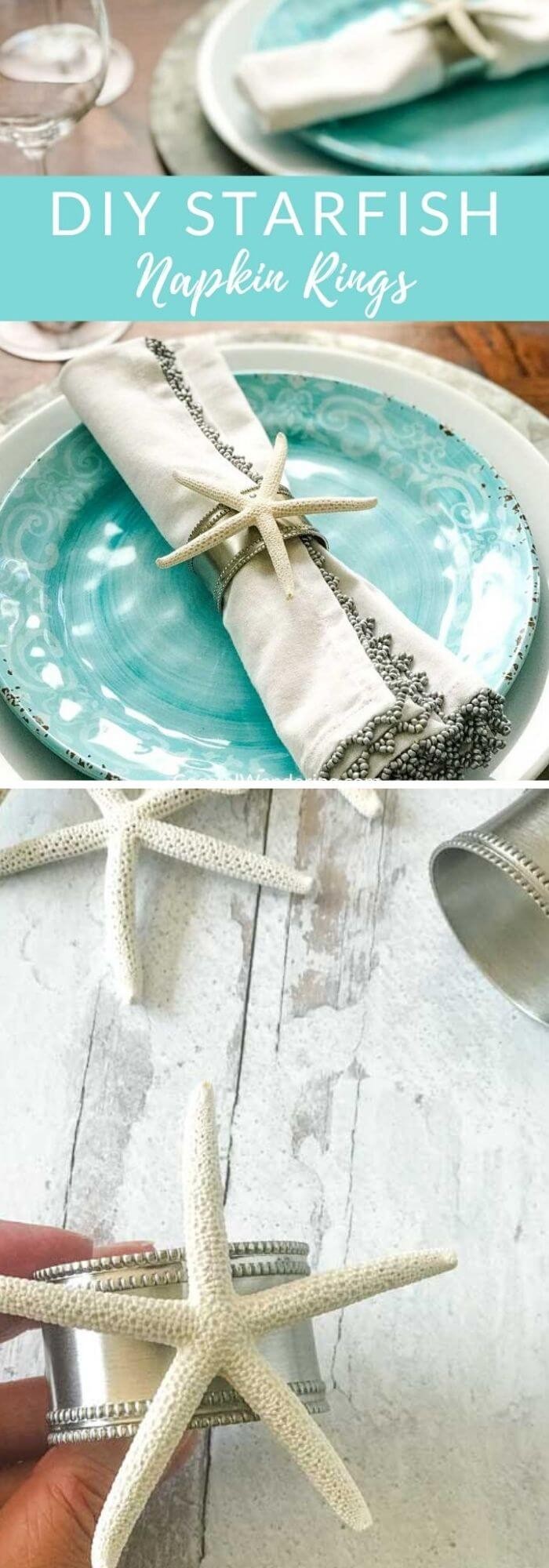15+ Innovative Concrete Edging Ideas To Transform Your Garden
Are you ready to take your outdoor space from ordinary to extraordinary? One simple yet effective way to achieve this is by incorporating concrete edging ideas into your garden design. Concrete edging isn’t just about aesthetics; it also offers practical benefits like durability, versatility, and low maintenance. In this article, we’ll explore 15 creative and doable concrete edging ideas that can elevate the look and functionality of your garden.
From straightforward to unique designs, we’ve got you covered across all styles and practical uses. Say goodbye to bland edges and hello to a transformed outdoor space that will stand the test of time! In this article, you’ll discover the benefits of using concrete edging, as well as tips on planning, materials, and installation techniques. Get ready to unleash your creativity and give your garden the solid foundation it deserves.
Benefits of Concrete Edging
Durability
Concrete has proven to be one of the most resilient options for garden edging, boasting a remarkable level of durability that allows it to withstand the test of time. Unlike other materials that may rot, warp, or deteriorate over the seasons, concrete remains steadfast and unblemished. Martha Stewart’s wise words echo the sentiment: ‘Durability in garden materials is essential.
‘ With concrete, you can rest assured that your garden edging will remain a testament to your love for gardening for years to come.
Versatility
Don’t let an unconventional yard shape get in the way of your creativity. Concrete edging is the perfect solution to tame even the most unique outdoor spaces. With its impressive range of shapes and sizes, you can effortlessly achieve smooth curves or sharp lines that perfectly complement your garden design. This flexibility makes concrete edging a top choice for any landscape project.
Low Maintenance
Concrete edging offers a low-maintenance solution for those who value their outdoor space and prefer to spend time enjoying it rather than constantly maintaining it. This type of edging is designed to be easy on the upkeep, requiring only an occasional hose-down to keep it clean. Unlike other materials that may require frequent painting or staining, concrete edging provides a no-fuss option for defining your garden’s boundaries.
Cost-Effectiveness
When seeking value without sacrificing durability, concrete edging emerges as a top contender. While often priced lower than metal or stone options, concrete edging can actually outlast its rivals, making it an astute choice for gardeners keen on balancing budget and quality. This affordable yet long-lasting material is an attractive solution for those looking to optimize their landscape investments.
Preparation and Considerations for Concrete Edging
Planning Your Design
Before embarking on a concrete garden project, it’s essential to visualize your desired outcome. A little forethought can spare you a great deal of frustration later on. To achieve the perfect layout, sketch out your garden design, taking into account the edging that will ultimately define its shape. Consider how curves or straight lines will harmonize with your flower arrangements and overall yard aesthetic.
Don’t rely solely on instinct; instead, draw inspiration from renowned landscapers like Jamie Durie, who emphasizes the importance of thorough planning in landscape design. By starting with a solid plan, you’ll be better equipped to bring your concrete garden vision to life.
Materials and Tools Needed
To embark on a DIY concrete edging project, it’s essential to gather the right tools. At the core of your arsenal will be a high-quality concrete mix. Next, you’ll need a sturdy wheelbarrow for efficient mixing. For shaping and placing the concrete, bring along shovels and edging forms (if you’re opting for a more precise approach). To achieve a smooth finish, don’t forget to include trowels in your toolkit. And, let’s be real, gloves are a must-have – concrete isn’t exactly gentle on your skin.
By sticking to this list, you’ll be well-equipped to tackle the project with confidence and precision.
Safety Tips
When working with concrete, safety should always be top of mind. To avoid an unpleasant trip to the emergency room, make sure to don a pair of safety goggles and gloves. These simple precautions can prevent serious damage to your skin and eyes. For added protection, consider wearing a dust mask as well. The last thing you want is to breathe in concrete dust while you’re trying to create a beautiful garden feature.
By prioritizing safety from the start, you’ll be able to work with confidence and enjoy the fruits of your labor without worrying about unintended consequences.
15 Concrete Edging Ideas
Classic Straight Edging
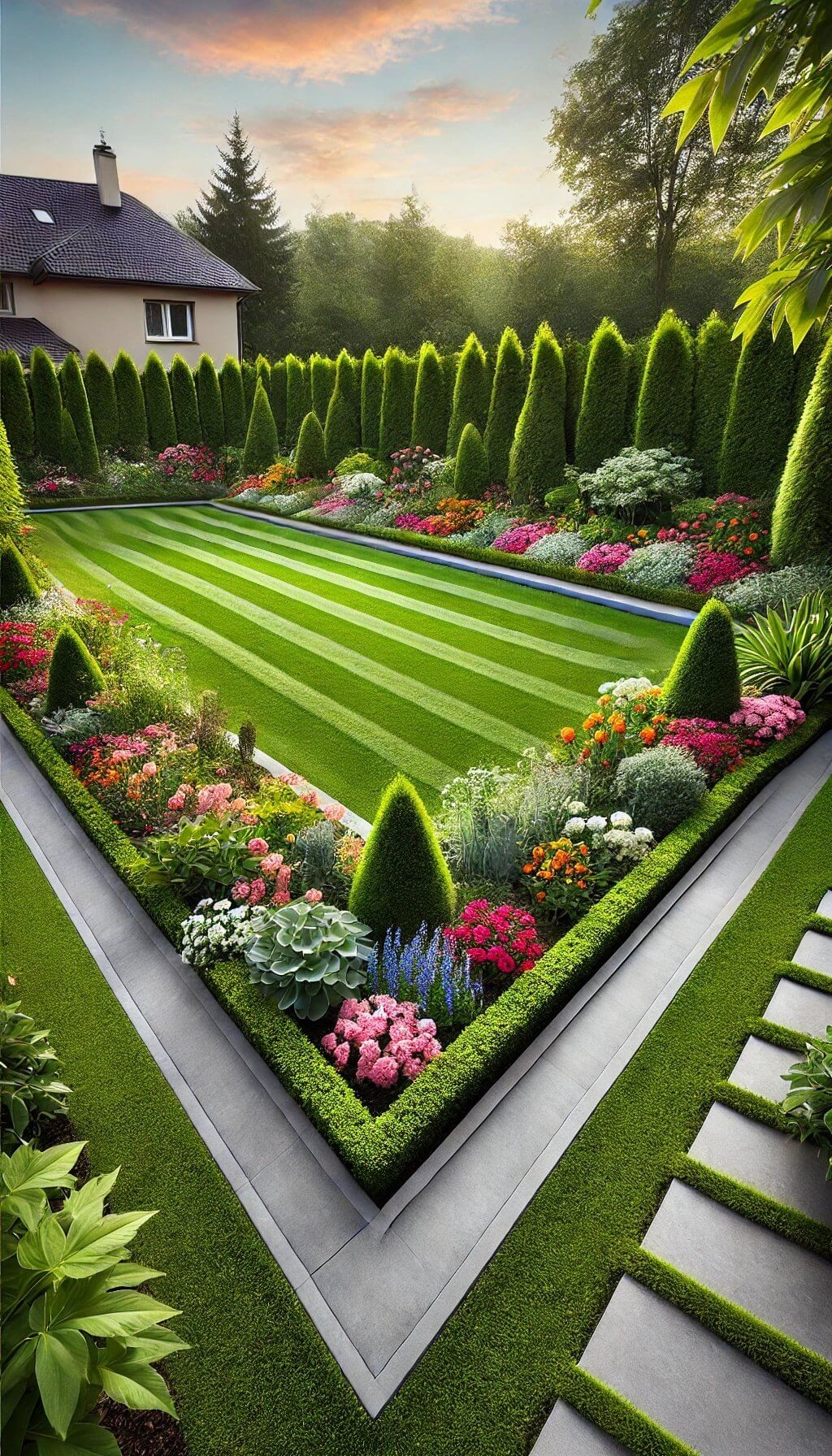
Embrace simplicity with classic straight edging, where crisp lines define your outdoor spaces. Garden beds, pathways, and driveways are transformed into visually appealing areas that exude a sense of tidiness. This straightforward approach is ideal for those who value neatness in their garden, just as they do in their home. Not only does it create a sharp visual aesthetic, but it also makes lawn maintenance a more efficient process.
Curved Edging
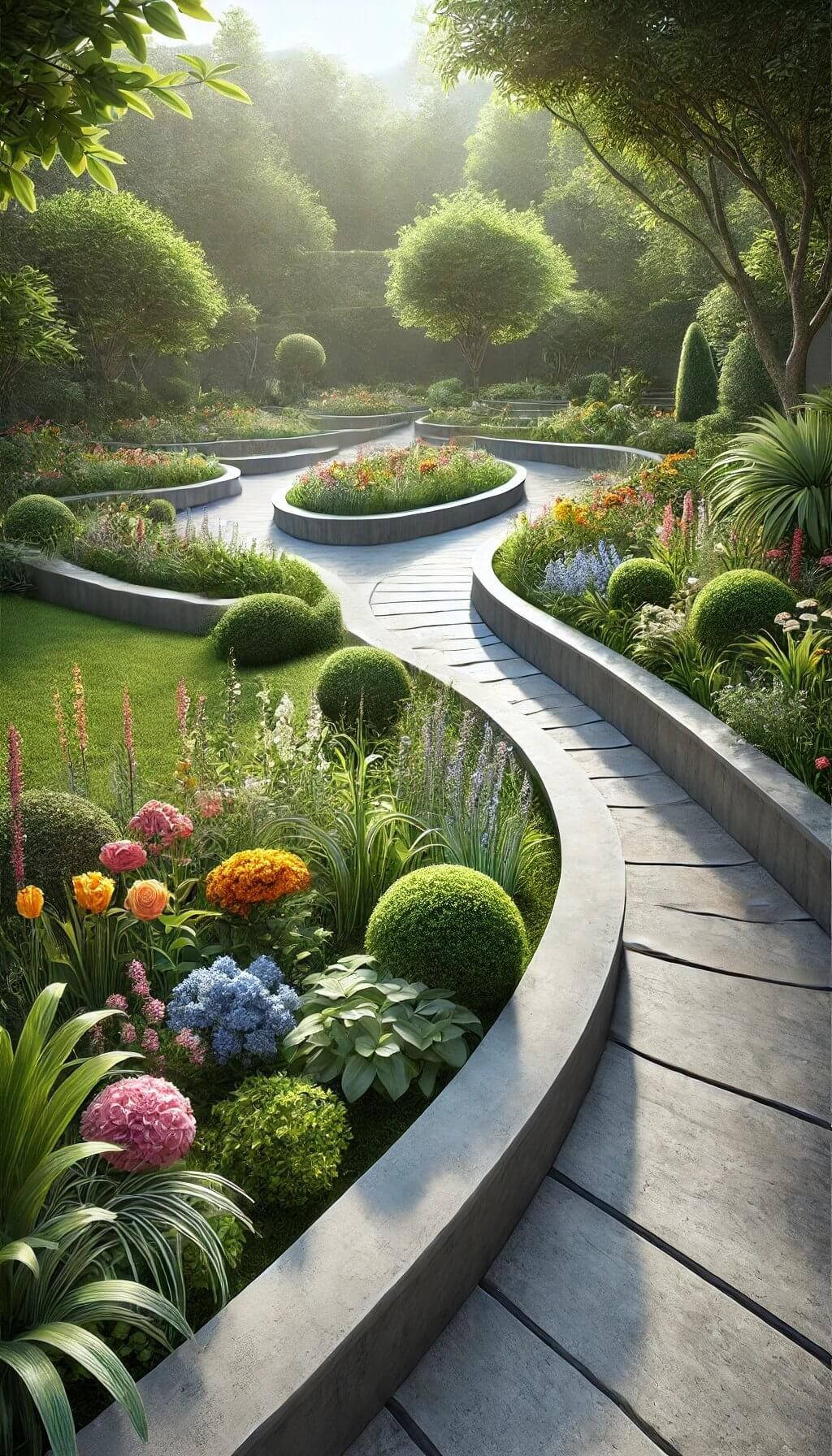
As you weave together the various elements of your garden, consider incorporating curved lines through the use of smooth curves with curved edging. This design choice can add a sense of softness and subtlety to the overall look, making it particularly well-suited for defining flower beds or borders. The gentle flow of curves encourages the eye to follow their path, creating a dynamic yet peaceful atmosphere that’s perfect for any outdoor space.
Stamped Concrete Edging

For those who appreciate intricate designs, stamped concrete edging offers a unique opportunity to bring a touch of sophistication to your outdoor spaces. By mimicking the appearance of stone, brick, and other natural textures, this innovative material can add a premium look to areas surrounding garden beds or patios, all without breaking the bank.
Colored Concrete Edging

Elevate your outdoor spaces by incorporating colored concrete edging into your garden paths and borders. This design element allows you to harmonize or juxtapose the hues with your home’s theme, infusing a personal touch that screams ‘This is my haven!’ It’s an effortless way to introduce character to the outdoors, transforming it from mere space to a reflection of your unique style.
Raised Concrete Edging
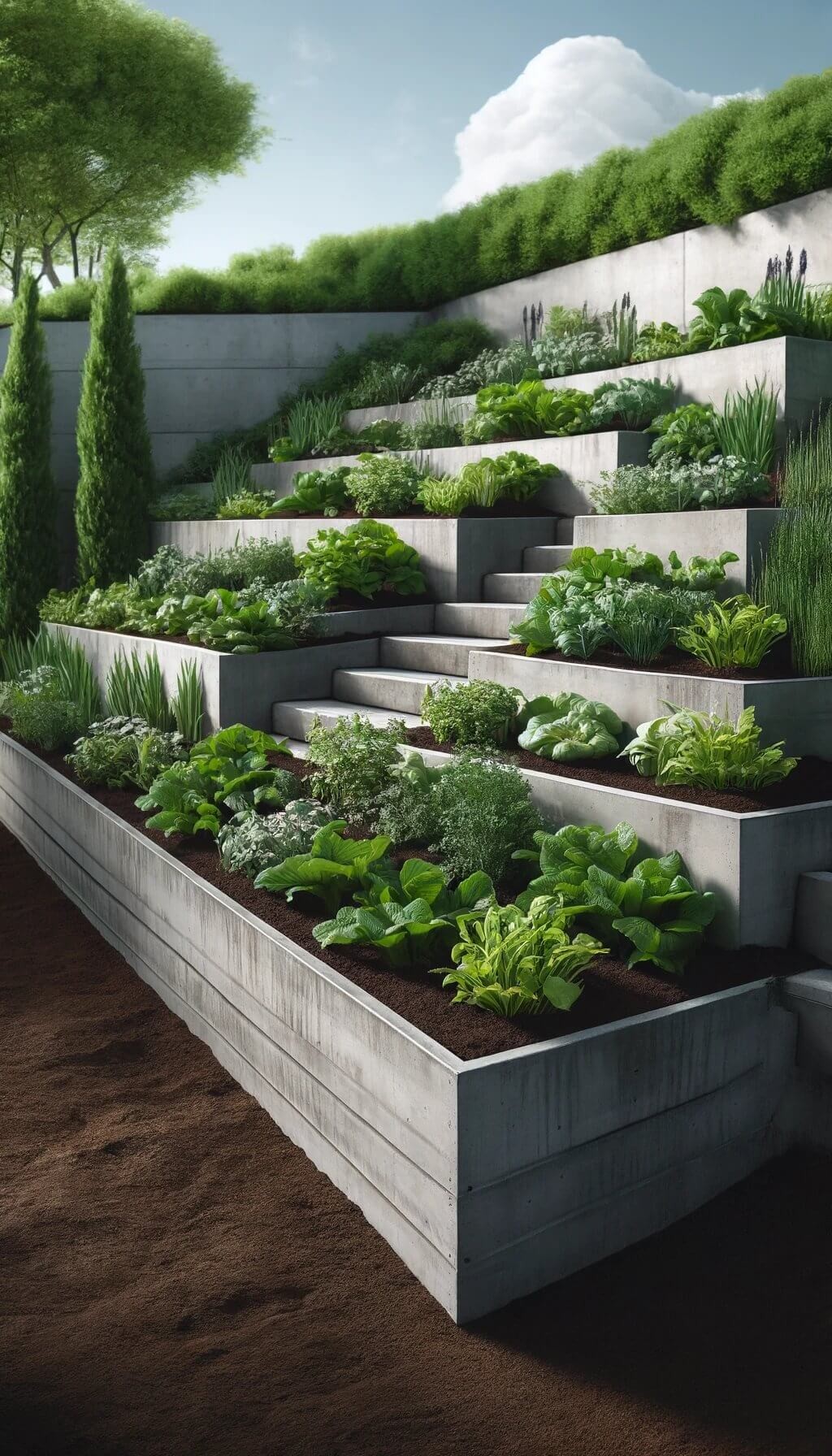
For gardens on a slope or raised beds, incorporating raised concrete edging is an intelligent decision. This design element not only helps define the garden beds but also serves as a barrier to prevent soil erosion. Moreover, it lends a visually appealing and sculptural dimension to your overall garden layout.
Textured Concrete Edging
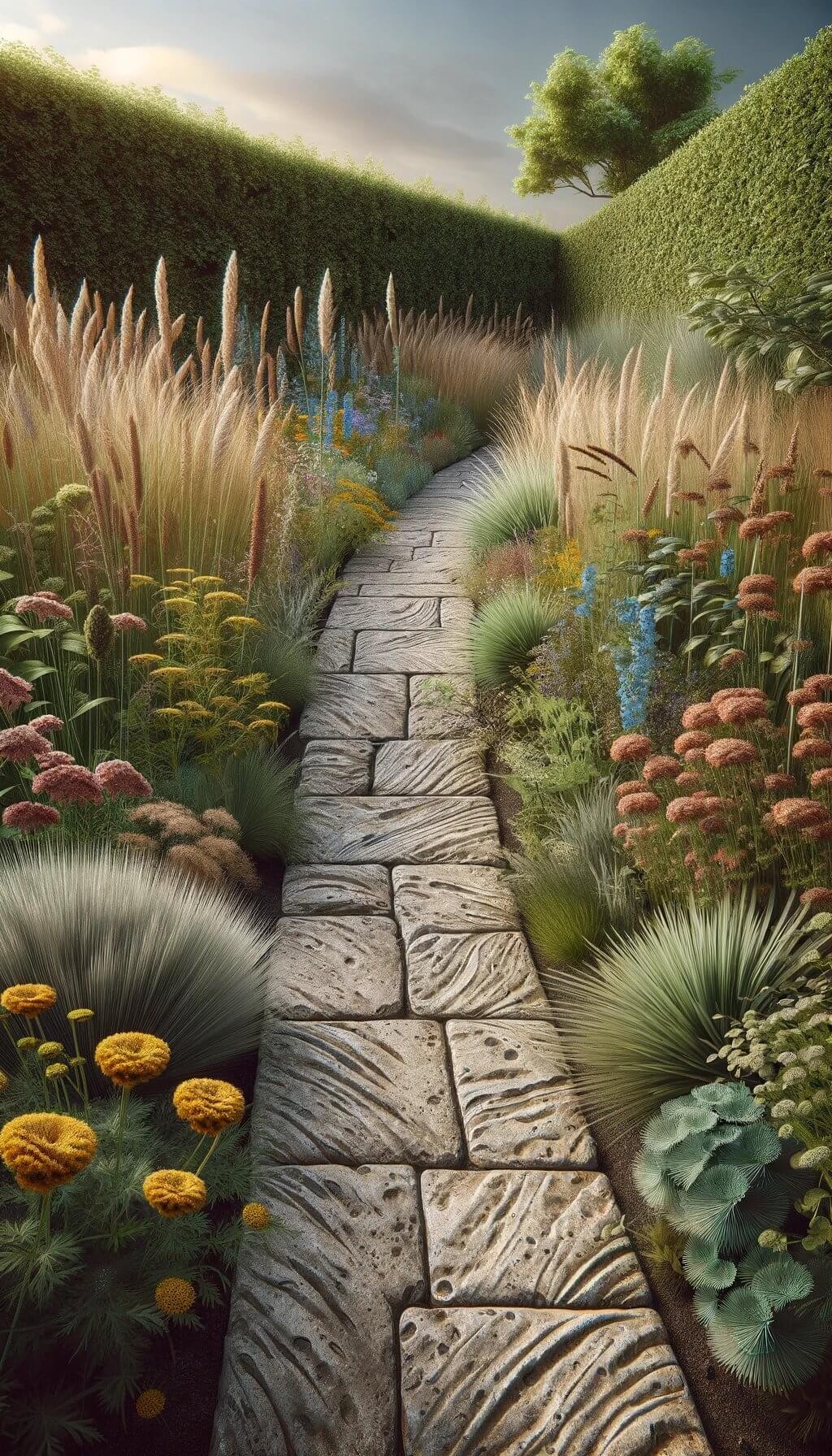
Infuse your outdoor space with the warmth of the natural world by incorporating textured concrete edging into your design. The rough, organic finish or subtle patterns evoke a sense of harmony between your garden and the surrounding landscape, as if your outdoor oasis is embracing the beauty of nature in a celebratory gesture.
Smooth and Polished Edging
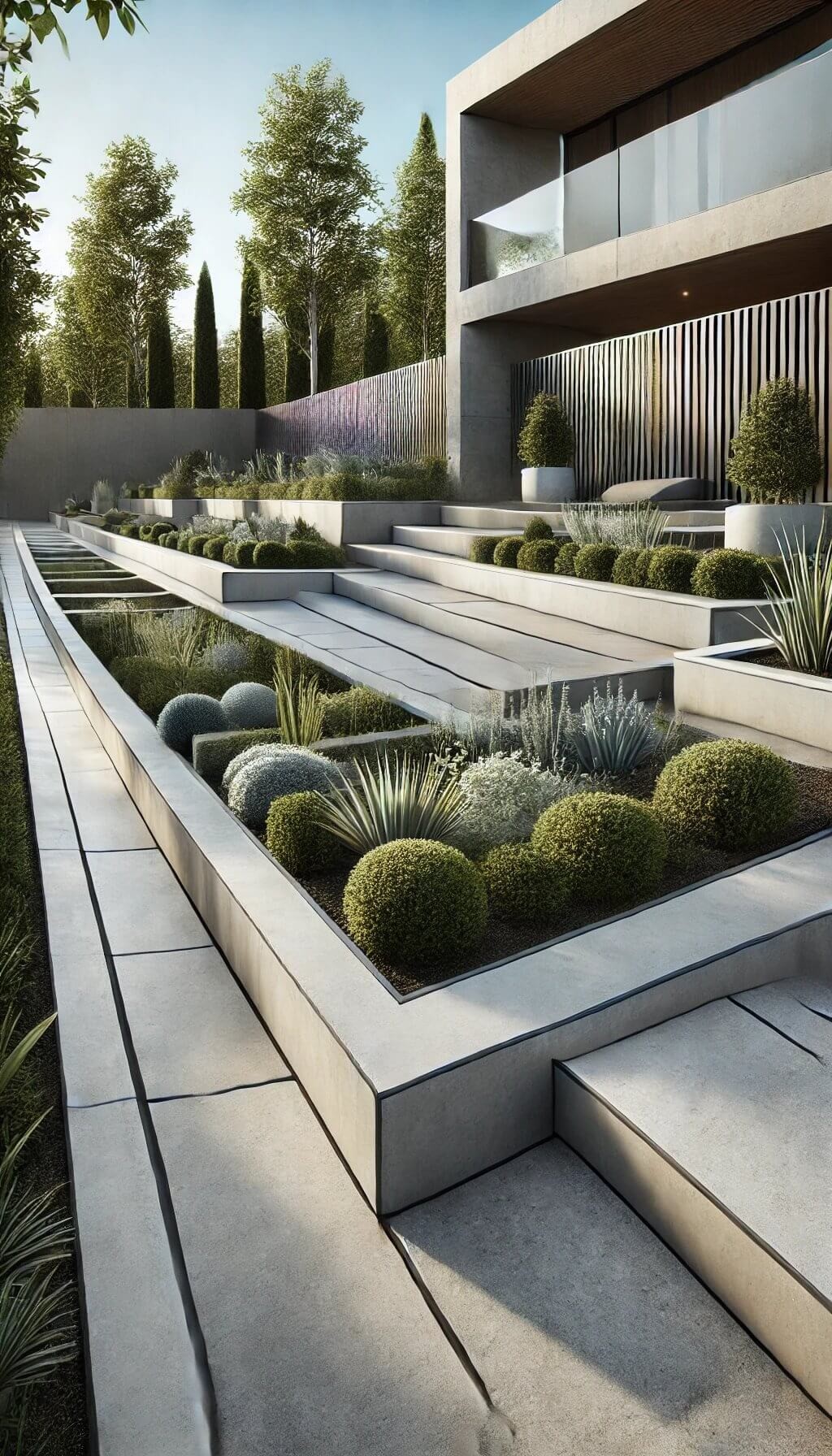
Achieve a modern and sleek garden aesthetic by opting for smooth and polished edging. This stylish choice excels in contemporary garden designs and minimalistic spaces, where its reflective properties truly shine. The way it catches light adds an air of sophistication, effortlessly creating a clean and updated look.
Concrete Block Edging
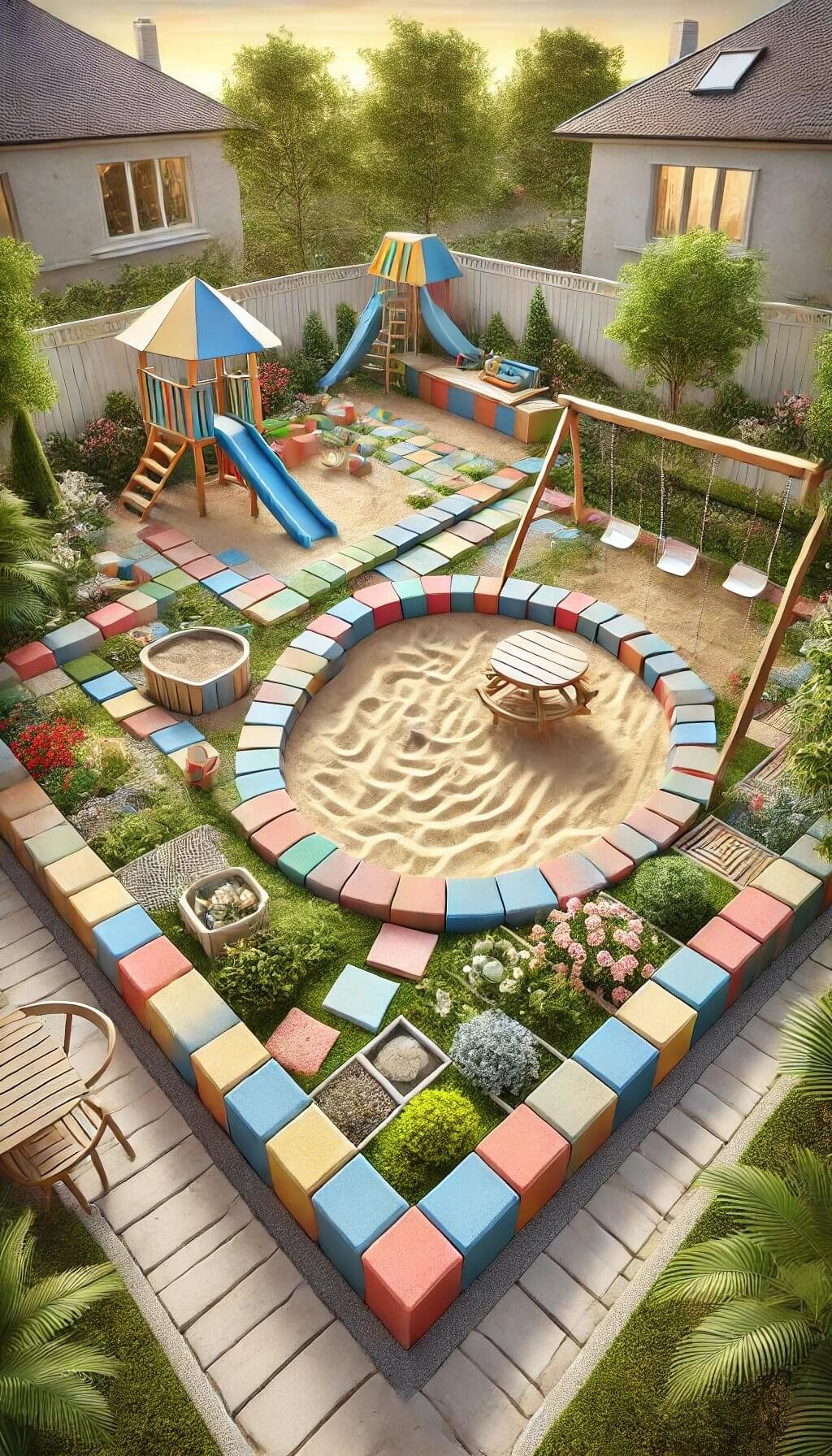
Concrete block edging presents a versatility that’s hard to match. With the ability to arrange blocks in various configurations, you’re free to create unique designs that harmonize with your garden’s dimensions. This creative freedom allows for a personalized touch, transforming your outdoor space into an aesthetically pleasing oasis.
Embedded Stone Edging

Embedded stone edging offers a distinctive aesthetic by combining concrete with stones, creating a visually appealing, tactile experience. This unique feature brings a touch of nature to pathways and garden borders, as if the very pathway itself were sharing its story.
Mosaic Concrete Edging
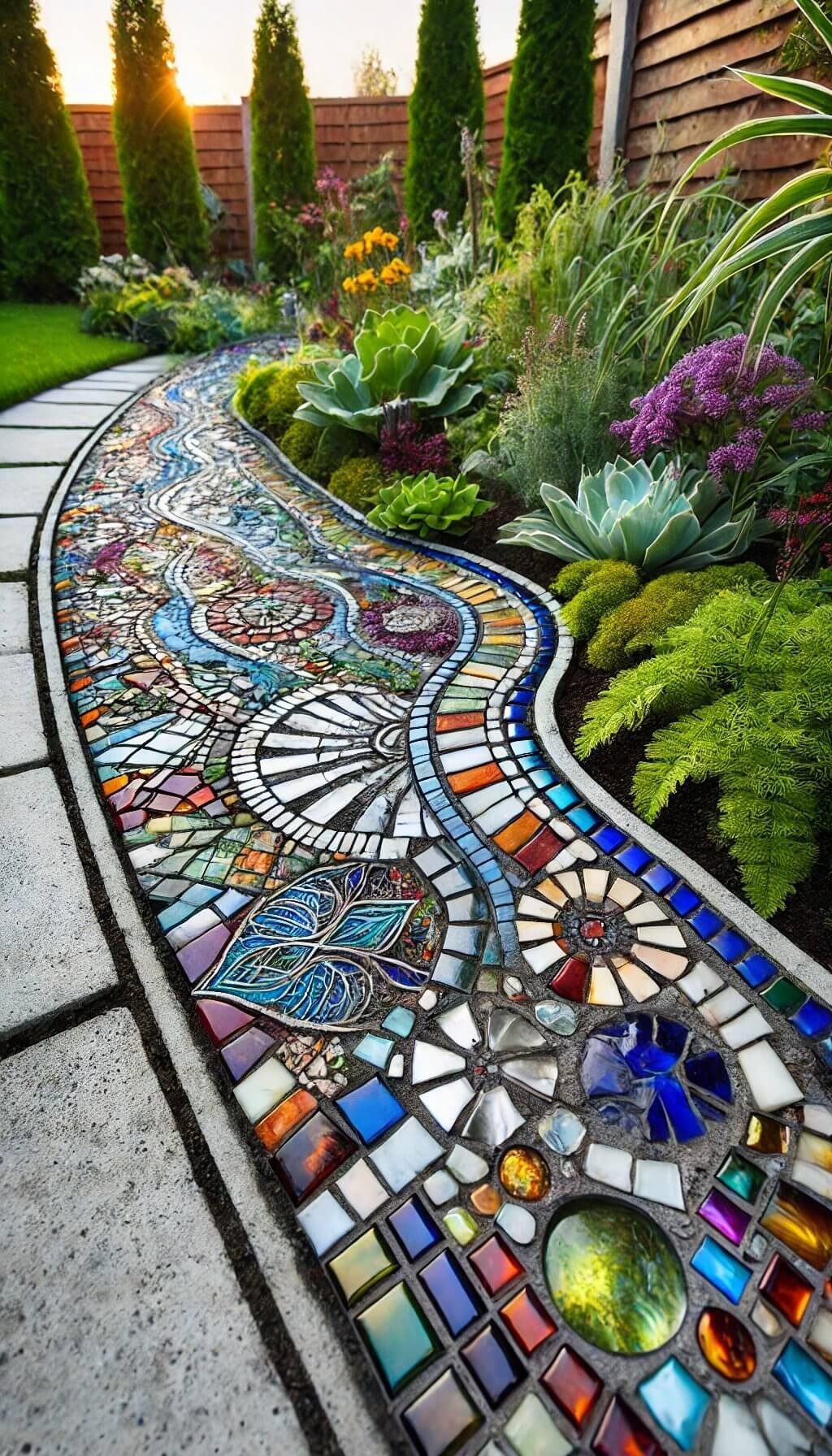
Take your garden design to the next level by introducing mosaic concrete edging, where tiles or glass pieces create vibrant and visually striking borders that will undoubtedly draw attention. By incorporating these colorful components, you’re essentially painting with stone, transforming your garden’s edges into an extraordinary work of art.
Lipped Concrete Edging
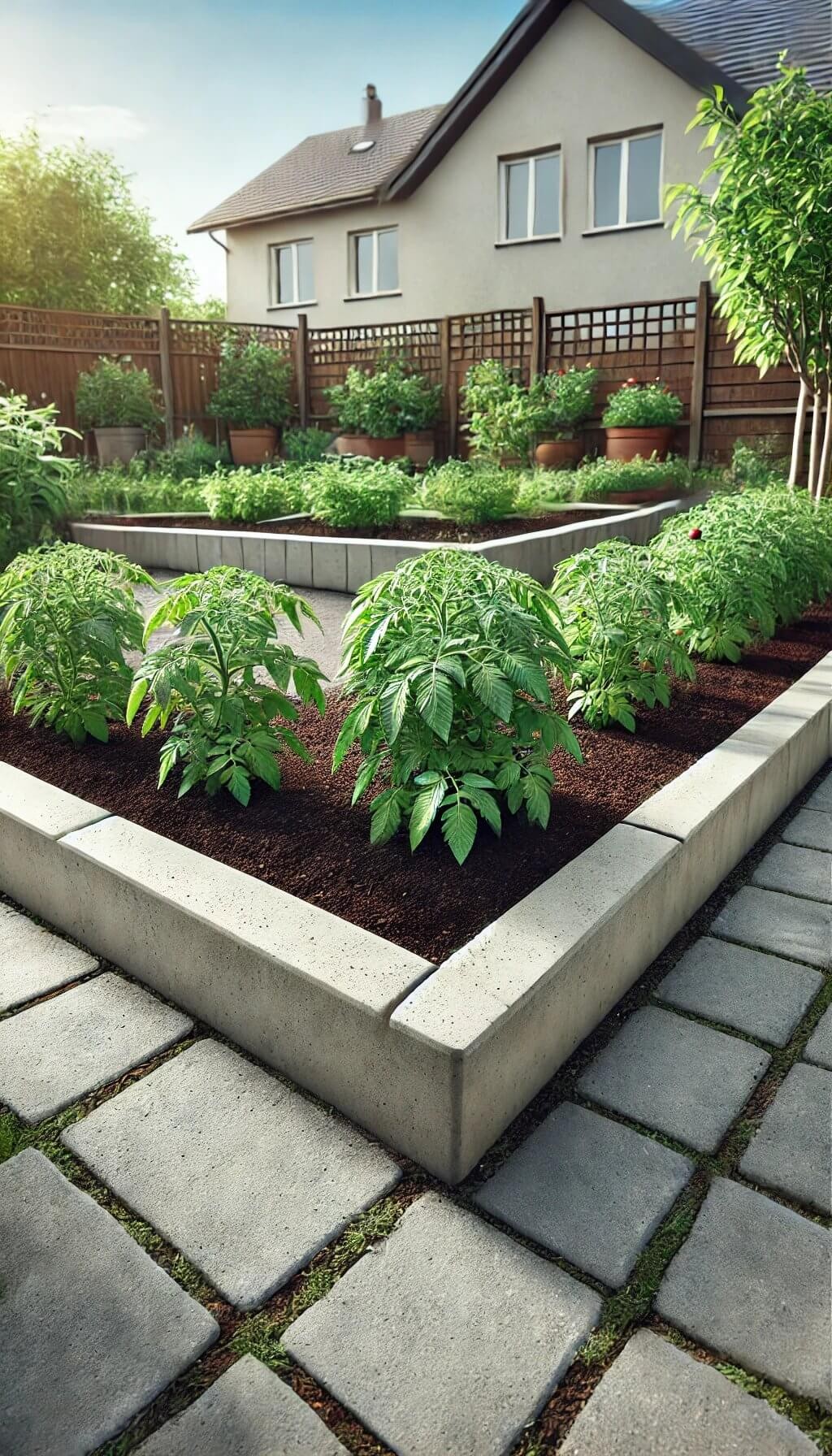
Concrete edging with a practical lip effectively contains mulch or soil within garden beds, ensuring optimal integrity and tidiness. This mini barrier creates a clear boundary, encouraging the soil to stay in place, while also keeping the surrounding area organized and visually appealing.
Patterned Concrete Edging

Patterned concrete edging provides a unique opportunity to infuse your garden’s design with artistic flair, subtly enhancing the visual appeal of pathways and borders without overpowering the overall aesthetic. By incorporating pre-cast designs, you can add a decorative touch that elevates the beauty of your outdoor space.
Geometric Concrete Edging

When you want your garden to truly stand out, geometric concrete edging is the way to go. Its sharp, angular lines create a structured aesthetic that’s perfect for modern and formal outdoor spaces. Imagine a harmonious blend of math and nature – the precise geometry adds a touch of sophistication to your garden, making it a true showstopper.
Tapered Concrete Edging

A seemingly understated feature, tapered concrete edging makes a thoughtful impression by gradually narrowing as it flows through your garden. This subtle yet effective design creates a gentle boundary that effortlessly bridges the gap between distinct sections, politely announcing the arrival of a new area with a soft, architectural whisper.
Glow-in-the-Dark Concrete Edging

As the sun sets, transform your garden paths into a beacon of light with glow-in-the-dark concrete edging. This innovative feature not only prioritizes safety by providing a clear path after dark but also amplifies ambiance, creating an enchanting atmosphere perfect for midnight strolls. The soft glow serves as a guiding force, making it seem like you’ve conjured up a little magic in your own backyard.
Installation Tips and Techniques for Concrete Edging
Step-by-Step Guide
To achieve professional-looking results when installing concrete edging, follow these steps. Start by planning the layout of your edging and digging a trench approximately 4 inches deep. Next, mix your concrete to the right consistency – not too runny, but not too thick either – and pour it into the trench. Use a trowel to smooth out the surface, ensuring it’s level and even. Be patient and allow the concrete time to set before you start celebrating your new edging.
As experienced landscaper Pete Moss advises, ‘Patience is key when working with concrete.’
Common Mistakes to Avoid
Before diving into the process of edging, it’s crucial to avoid common mistakes that can ruin the final result. One such mistake is skipping the preparation stage. A poorly dug trench can cause uneven edges that lack polish. Additionally, getting the water-to-concrete mix wrong can lead to a weakened structure. It’s essential to take your time and not rush the process of setting concrete. Moving too quickly can result in cracks and a weak bond between the old and new surfaces.
Instead, adopt a slow and steady approach to ensure a professional-looking finish.
Maintenance Advice
To ensure your concrete edging remains in pristine condition, routine maintenance is key. Start by giving it a yearly deep clean using a hose and stiff brush to remove dirt and debris that may have accumulated. If you notice any minor cracks or chips during this process, they can be easily repaired with a simple patching job using fresh concrete mix. As gardening expert Lily Fields advises, ‘Regular checks are crucial in keeping your concrete edging well-maintained.
‘ By staying on top of these small tasks, you’ll be able to enjoy the long-lasting benefits of your outdoor space without worrying about the visual appeal of your concrete edging taking a hit.
Conclusion

With concrete edging, the possibilities are endless! We’ve explored a diverse range of styles, from timeless straight lines to innovative glow-in-the-dark designs that illuminate garden pathways. Whether you’re looking for bold and modern or subtle and traditional, concrete offers both aesthetic appeal and functional practicality. It’s your garden’s trusted companion, keeping everything tidy while showcasing its own unique beauty. Now’s the perfect opportunity to turn these ideas into a reality.
Get hands-on and start crafting your very own concrete edging project! As landscape expert Edna Gardner so aptly puts it, ‘The only way to truly understand your garden is to create it yourself.’Don’t forget to share your progress or any clever ideas that come to mind in the comments section. If you have questions or need guidance, feel free to drop them below. Let’s keep our gardens thriving and our edges crisp!
FAQs about Concrete Edging
What are the best materials for DIY concrete edging projects?
When it comes to concrete edging projects, several essential materials are needed to achieve the desired outcome. The foundation of any successful project lies in obtaining high-quality concrete mix, which provides the structural integrity of the finished product. Wooden forms or molds serve as the framework for shaping the concrete into its final form. A reliable trowel is also crucial for smoothing out the surface and removing any imperfections.
Additionally, reinforcement materials such as rebar or wire mesh can be employed to enhance the durability and structure of more complex designs.
How do I choose the right style of concrete edging for my garden?
The style of garden edging ultimately hinges on the overall aesthetic you’re striving for in your outdoor space, as well as your personal taste. For a sleek, contemporary look, smooth and polished concrete edging could be an excellent choice. Conversely, if you’re aiming for a more rustic or traditional appearance, textured or stamped concrete can bring a sense of depth and character to your garden’s design.
In either case, consider how the edging will interact with existing elements in your garden, such as pathways, plantings, and hardscapes, to create a cohesive and visually appealing whole.
Can concrete edging be customized with colors and patterns?
Concrete’s versatility is one of its most attractive features. Not only can it be customized with a vast array of colors and patterns, but it can also be manipulated before or after setting to achieve the desired look. Pigments can be added to the mix before curing, allowing for a wide range of hues to be incorporated into the final product. Alternatively, concrete surfaces can be painted or stained after they’ve hardened, providing an additional layer of customization.
Furthermore, designs and patterns can be pressed into the wet concrete using molds or stencils, enabling the creation of intricate and unique designs. Whether you’re looking for a bold statement piece or a subtle accent, concrete’s adaptability makes it an ideal material for achieving your desired aesthetic.
What are some common mistakes to avoid when installing concrete edging?
When it comes to achieving a professional-looking finish with your concrete project, there are a few common mistakes that can easily be avoided. One crucial aspect is ensuring you properly prepare the surface, as neglecting this step can result in uneven or unstable edging. Additionally, incorrectly mixing the concrete can significantly impact its durability and appearance, making it vital to get this right.
Furthermore, allowing sufficient time for the concrete to cure fully before removing any forms or applying weight or pressure to the edging is essential. Rushing through these steps can lead to subpar results and even damage the final product.
How long does concrete edging last, and how can I maintain its appearance?
Concrete edging’s exceptional durability allows it to withstand the test of time, requiring only occasional upkeep to preserve its pristine condition. A gentle rinse with a hose and light brushing off any loose debris are all that’s needed to keep it looking its best. As for minor imperfections that may arise over the years, such as cracks or chips, a straightforward concrete patching process can be employed to extend its lifespan and maintain its visual appeal.




